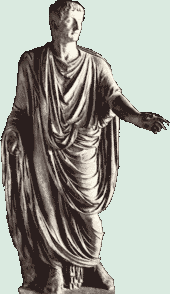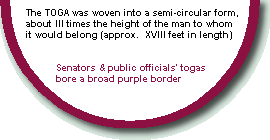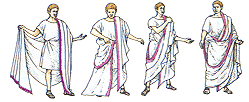Villa Ivlilla's Toga Page is
featured as part of KiddoNet's
Detective Mystery game on ancient Rome. Multas gratias, KiddoNet!
|

|

|
 |
When any illustrious member dies, the family takes the
images to the funeral, puting them on...actors [who] puton a
purple-bordered toga if their character was a consul or praetor, an
entirely purple toga of he was a censor, and a gold-embroidered toga
if he had celebrated a triumph.
— Polybius, History of the World 6.53-6.5.4.3
|
|

|
 |
|
|
 Much as Roman
clothing can be said to resemble that of the Greeks, the toga
is distinctive to Romans. The toga is descended from the
Etruscan tebenna, and in the early
days of Rome was probably woven of coarse, undyed wool. Later
though the toga was woven from, soft wools, linens - even silk
- during the late Roman empire. Much as Roman
clothing can be said to resemble that of the Greeks, the toga
is distinctive to Romans. The toga is descended from the
Etruscan tebenna, and in the early
days of Rome was probably woven of coarse, undyed wool. Later
though the toga was woven from, soft wools, linens - even silk
- during the late Roman empire.
The toga was never worn by itself, unlike its cousin, the
Greek himation. It was
worn always over a tunica,
which in the republic and early empire, bore clavi -
broad vertical stripes - borrowed from the Etruscans.
Begun as a strictly utilitarian garment, the toga evolved
into a ceremonial robe the carried such overtones of the Roman
qualities of dignitas
and gravitas
that in later times it was seldom worn except on state
occasions. Only citizens with voting rights could wear it, and
colour and decoration was strictly regulated according to
status.
|
|

Wearing the Toga


| Drape
the left- hand end over the left
shoulder |
Fold
the right hand end over in the middle, gather it
into a roll and throw it over the left
shoulder. |
The
rest of the right- hand piece is folded and thrown
over the left shoulder. |
A
part of the left- land piece is pulled up and
tucked into the
belt. | |
Gradually, colours
began to distinguish class and professions:
blue for
philosophers
black for
theologians
green for practitioners
of the medical arts.
Soothsayers wore an unornamented
white toga.
Peasants were allowed only one
sober colour.
Officers were allowed garments of
two colours
Clan commanders could wear
three colours
Members of the Imperial household wore
as as many as seven colours.
|
 Candidates for public office wrapped themselves in the
toga candida,
bleached to a dazzling white at the fullers, to signify the
purity of their intentions. Candidates for public office wrapped themselves in the
toga candida,
bleached to a dazzling white at the fullers, to signify the
purity of their intentions.
Augurs and certain priests wore the toga
trabea, decorated with a scarlet stripe and purple
hem. Victorious generals (and later emperors and consuls) were
awarded the purple toga
picta, embroidered with palm leaves. Mourners wrapped
their grief in an inky toga
pulla.
Fate of the Toga
As the Republic ballooned into an empire, so expanded the
toga, until it measured XX feet in length, and VII - X feet in
width; no doubt causing Tertullian to complain, "This is no
garment but a burden."
Officials continued to wear the toga until the fifth
century, but after the fall of the Empire, it had shrunk to a
mere VI feet in length, and the average Roman citizen had
given up on the toga altogether, bringing it out only for
festivities and funerals.
Sources
A History of Costume, Rachel
Kemper
Historic Costume,
Katherine Lester
A History
of Costume, Clark Kohler
The Romans: Their Life &
Customs,
E. Guhl & W.
Koner
See also Richard Heli's excellent
Toga
Page
|
|
Updated
|
|

|
|


 Much as Roman
clothing can be said to resemble that of the Greeks, the toga
is distinctive to Romans. The toga is descended from the
Etruscan tebenna, and in the early
days of Rome was probably woven of coarse, undyed wool. Later
though the toga was woven from, soft wools, linens - even silk
- during the late Roman empire.
Much as Roman
clothing can be said to resemble that of the Greeks, the toga
is distinctive to Romans. The toga is descended from the
Etruscan tebenna, and in the early
days of Rome was probably woven of coarse, undyed wool. Later
though the toga was woven from, soft wools, linens - even silk
- during the late Roman empire.

 Candidates for public office wrapped themselves in the
Candidates for public office wrapped themselves in the
